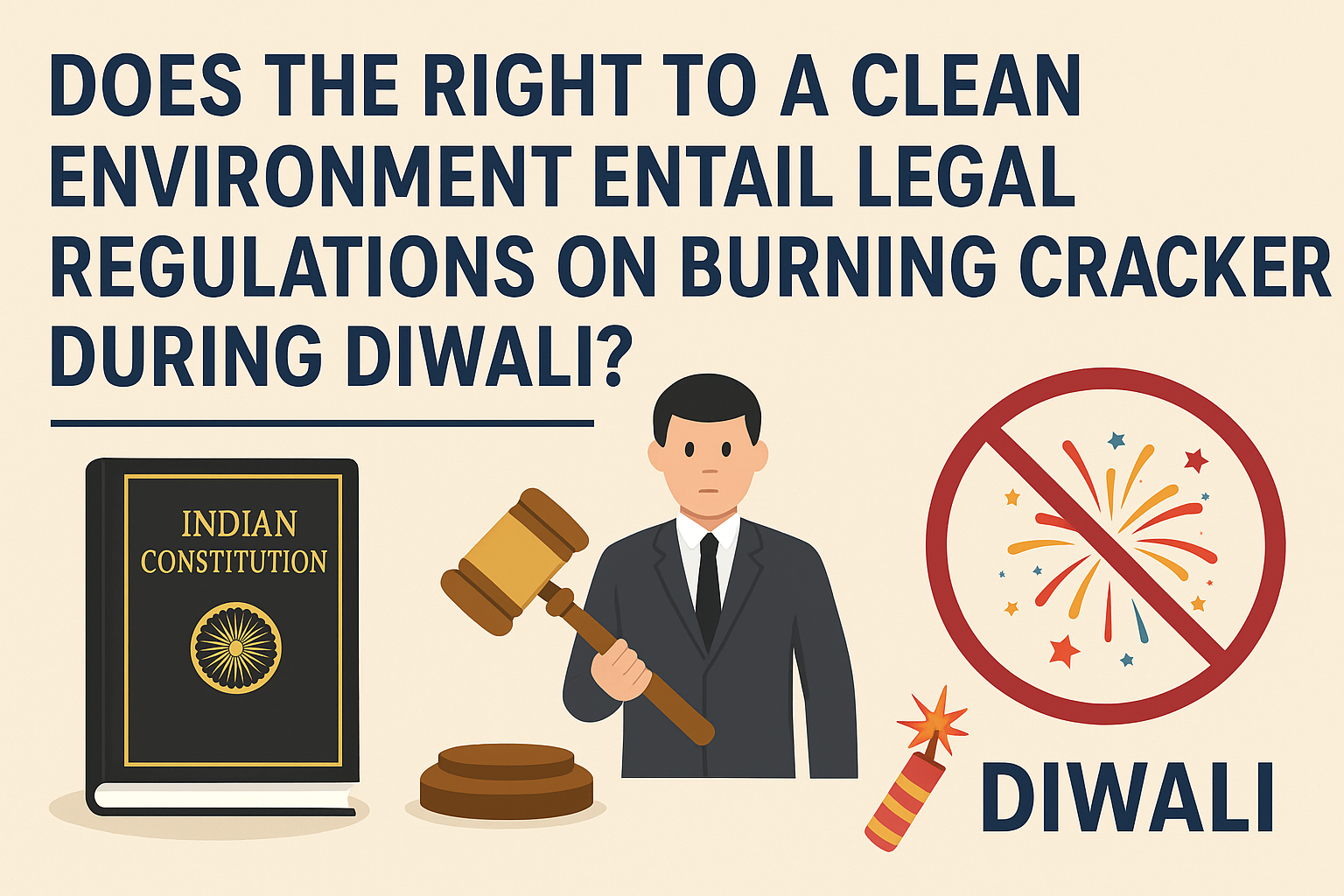View News
An Analysis in the Light of Article 21 of the Indian Constitution and Supreme Court Judgments

Does the Right to a Clean Environment Entail Legal Regulations on Burning Crackers During Diwali?
An Analysis in the Light of Article 21 of the Indian Constitution and Supreme Court Judgments
Introduction
The right to a clean and healthy environment has evolved as an indispensable facet of the fundamental right to life under Article 21 of the Indian Constitution, which guarantees that “No person shall be deprived of his life or personal liberty except according to procedure established by law.” Over the years, judicial interpretation has expanded the meaning of “life” to encompass not merely physical existence, but the right to live with human dignity, free from pollution and environmental degradation.
A clean environment is not a luxury but a constitutional necessity. The Supreme Court has repeatedly recognized that the right to life includes the right to clean air, potable water, and pollution-free surroundings. In the context of India’s diverse cultural fabric, festivals like Diwali, celebrated with fervour and enthusiasm, have increasingly come under legal scrutiny for their impact on air and noise pollution — particularly due to the burning of firecrackers.
Thus arises a constitutional question: Can the right to a clean environment justify legal restrictions on burning firecrackers during Diwali?
The Constitutional Foundation: Article 21 and Environmental Jurisprudence
The Indian judiciary has interpreted Article 21 as a living, dynamic provision capable of encompassing evolving societal needs. The right to a clean and healthy environment has been judicially read into this Article through a series of landmark rulings such as:
-
Subhash Kumar v. State of Bihar (1991) – The Supreme Court held that the right to life includes the right to enjoyment of pollution-free water and air for full enjoyment of life.
-
M.C. Mehta v. Union of India (1987 onwards) – A series of environmental PILs where the Court expanded the ambit of Article 21 to include protection of the environment, imposing duties on both the State and citizens under Article 51A(g) to safeguard nature.
Consequently, the right to a clean environment has emerged as a derivative yet enforceable fundamental right under Article 21, compelling the State to regulate human activities — including cultural practices — that threaten ecological balance.
Judicial Approach to Firecrackers and Diwali Pollution
1. M.C. Mehta v. Union of India (2001)
The Supreme Court, in this case, recognized that unregulated bursting of firecrackers leads to serious health hazards and noise pollution, adversely affecting children, elderly people, and animals. The Court directed the Central Government to prescribe noise standards under the Environment (Protection) Act, 1986 and implement restrictions on the timing and location of firecracker use, especially in residential areas.
This judgment laid the groundwork for integrating environmental protection into cultural celebrations, without entirely prohibiting traditional practices.
2. Arjun Gopal v. Union of India (2017)
Triggered by alarming levels of smog and pollution in Delhi-NCR post-Diwali, this case marked a watershed in India’s environmental jurisprudence. The Supreme Court, invoking Article 21, imposed a temporary ban on the sale of firecrackers in Delhi-NCR. The Court emphasized that the right to life and health of citizens cannot be compromised for short-lived enjoyment.
It directed the Central Pollution Control Board (CPCB) to conduct a detailed study on the impact of firecrackers on air quality, observing that the bursting of crackers contributed significantly to the degradation of air quality index (AQI), especially during the winter months.
3. Arjun Gopal (2018) – Green Crackers and Regulatory Guidelines
In a follow-up judgment, the Supreme Court laid down comprehensive guidelines for the use of firecrackers, introducing the concept of “green crackers” — firecrackers designed to reduce particulate matter, smoke, and noise levels. The Court issued directions, inter alia:
-
Only green crackers with reduced emission levels are permitted.
-
Fixed time slots: bursting allowed only between 8 PM to 10 PM during Diwali, and for limited durations during other festivals.
-
Licensing regulations: sale and manufacture restricted to authorized entities.
-
Community celebration zones: specific areas designated for collective celebrations to minimize dispersed pollution.
The Court made it clear that these restrictions were not anti-festival but pro-health and pro-environment, aiming to balance cultural rights under Article 25 with the environmental rights under Article 21.
Legal Framework Supporting the Restrictions
The judicial orders have been supplemented by statutory provisions and executive regulations under various environmental laws, including:
-
The Environment (Protection) Act, 1986 – Empowers the Central Government to take measures to control and reduce environmental pollution.
-
Noise Pollution (Regulation and Control) Rules, 2000 – Lay down permissible decibel limits for firecrackers and prohibit their use during night hours except for special occasions.
-
Explosives Act, 1884 and Explosives Rules, 2008 – Regulate the manufacture, sale, and use of explosive materials, including fireworks.
-
Air (Prevention and Control of Pollution) Act, 1981 – Enables action against activities contributing to air pollution, especially in non-attainment cities like Delhi.
Through these enactments, the judiciary’s directives have found statutory reinforcement, ensuring enforceability at the administrative level.
Balancing Cultural Rights and Environmental Obligations
The Supreme Court has consistently reiterated that no fundamental right is absolute. While citizens enjoy the right to celebrate religious and cultural festivals under Article 25, such rights are subject to public order, morality, health, and other fundamental rights.
In this context, the Court has adopted a balancing approach, asserting that religious freedom cannot override the fundamental right to life and health. The idea is not to prohibit celebrations but to promote sustainable and eco-friendly alternatives.
The evolution of “green crackers” and regulated timings symbolizes a judicial attempt to harmonize tradition with sustainability, echoing the constitutional philosophy of harmony between rights and duties under Article 51A(g) — the duty to protect and improve the natural environment.
Conclusion
The Supreme Court’s progressive environmental jurisprudence under Article 21 establishes that the right to a clean environment is an integral part of the right to life, and it necessarily entails legal regulations on activities causing environmental degradation — including the burning of crackers during Diwali.
Judicial interventions such as those in M.C. Mehta and Arjun Gopal have shaped India’s environmental policy by balancing ecological preservation with cultural sensitivity. These decisions underscore that safeguarding public health and environmental integrity must take precedence over unrestricted cultural practices.
Thus, legal regulations on firecrackers are not a denial of tradition but an affirmation of constitutional responsibility — ensuring that the joy of festivals does not come at the cost of citizens’ right to breathe clean air.
References
-
M.C. Mehta v. Union of India, (2001) 3 SCC 756.
-
Arjun Gopal v. Union of India, (2017) 1 SCC 412.
-
Arjun Gopal v. Union of India, (2018) 9 SCC 499.
-
Subhash Kumar v. State of Bihar, (1991) 1 SCC 598.
-
Environment (Protection) Act, 1986.
-
Noise Pollution (Regulation and Control) Rules, 2000.
Unlock the Potential of Legal Expertise with LegalMantra.net - Your Trusted Legal Consultancy Partner”
Disclaimer: Every effort has been made to avoid errors or omissions in this material in spite of this, errors may creep in. Any mistake, error or discrepancy noted may be brought to our notice which shall be taken care of in the next edition In no event the author shall be liable for any direct indirect, special or incidental damage resulting from or arising out of or in connection with the use of this information Many sources have been considered including Newspapers, Journals, Bare Acts, Case Materials , Charted Secretary, Research Papers etc
Mayank Garg
LegalMantra.net Team

